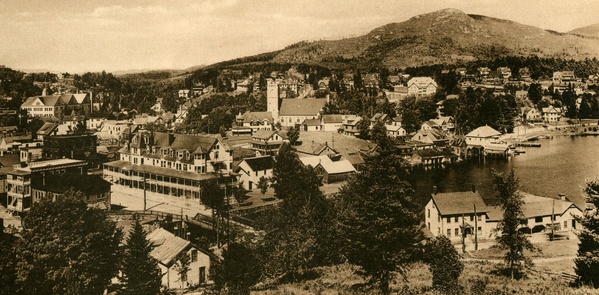 Saranac Lake Village, from an undated brochure by E. L. Gray & Co., c. 1920. Courtesy of Natalie Leduc. Saranac Lake Village, c. 1920
Saranac Lake Village, from an undated brochure by E. L. Gray & Co., c. 1920. Courtesy of Natalie Leduc. Saranac Lake Village, c. 1920
SARANAC LAKE... is the metropolis of these mountains. The name is somewhat confusing because the village lies a mile away from the shores of the beautiful lake whose name it bears. In the early days, when the village was hardly a hamlet, people spoke of it as "the settlement at Saranac Lake". This designation was precise enough in those days, but it has outlived the conditions that once made it obvious.
No one foresaw, moreover, that it was to become one of the most familiar place-names in the country, and would be known to scientists in every corner of the world. Fifty years ago it was a primitive lumber hamlet, with a saw-mill where the electric power-house now stands, and a few widely scattered houses. Then one or two hotels sprung up in and around the place to take care of the sportsmen and vacationists that were beginning to discover the charms and beauties of a wilderness at their back door.
A very limited and gradual development along these lines seemed all there was in store for this little backwoods settlement. Then something happened which, unimportant as it seemed at the time, was to give its destiny an unexpected twist and make Saranac Lake one of the most noted and efficient health resorts in the world.
In 1876, Dr.E. L. Trudeau settled here, without at the time having the faintest idea that by doing so he was to make himself and his home famous. He was then a young doctor who had just begun to practice, when his health broke down and he was told to leave the city. He chose Paul Smith's, because he had hunted and fished there in happier days, and liked the place and the people. He spent a summer there, and his health improved so much that he decided to spend the winter in the mountains. As the Smiths were going to close, he moved over to Saranac Lake.
At that time Saranac Lake had a population of 300 or 400. It had two stores and two hotels—one called "Bloods" which is the present Riverside Inn, and the other, "The Berkeley", still bearing its original name. Across the street from the "Berkeley" there was a little school house on the site of the present large one, and the Episcopal Church —the first church in the place—had just been built.
A bird's-eye view of it 40 years later shows how this little hamlet has blossomed into a sightly city of the woods. It now has a population of over 6,000. It has miles of macadam streets and cement walks, all electric lighted. It has a water supply from a mountain lake two miles away. It has 800 private residences; 150 buildings in which housekeeping suites are rented; one large, modern apartment house; 13 hotels; 70 stores; between 30 and 40 liveries, renting horses and cars, and several large public garages. It has two national banks, a telephone exchange, two telegraph offices, a union station, three large modern school buildings, a library, two hospitals, a boys' clubhouse with gymnasium, two theatres, four churches and a golf club with a very attractive course beautifully situated on the State Highway between Saranac Lake and Lake Placid.
Saranac Lake is on the Roosevelt Memorial Highway, which, afler leaving Plattsburg, winds into the mountains through the wonderful Wilmington Notch to Lake Placid and Saranac Lake Village, emerging at M alone on the opposite side of the mountains. The State System of Highways in the Adirondacks is quite complete. One on the East side of the mountains comes north from Albany to Saratoga, Lake George, Schroon Lake. Elizabethtown, Keene. Wilmington Notch, Lake Placid, Saranac Lake, and another from the West through Watertown, Canton, Potsdam, Malone and Paul Smiths to Saranac Lake. In short there are excellent roads all through the Adirondack's now and they all lead to Saranac Lake.
This makes it the most convenient starting point and equipment centre for excursions into the vast vacation land that lies around it. Moreover the State owns land—and it owns some two million acres in the Adirondack Park—open for enjoyment by the temporary camper. Those wishing to occupy a site on any of this State owned land may do so by obtaining a permit from the Conservation Commission at Albany, N. Y. The Commission will also furnish travel routes and helpful suggestions for all wishing to enjoy the unusual vacation opportunities that lie free for all in the woods and waters of the Adirondack Mountains. Information about Saranac Lake and the Adirondacks will be furnished by the Hoard of Trade or by the publishers of this album.
All lovers of the Adirondacks will be pleased to know that a history of them has been written and is in the press. It will tell for the first time in consecutive and narrative form the often thrilling story of these lakes and mountains, tracing their development from an unknown wilderness into the most convenient and popular of pleasure parks. The book will be published during the coming winter, and notice of publication will gladly be sent to anyone mailing their address to
E. L. GRAY & CO. 63 Main Street, Saranac Lake, N. Y.



